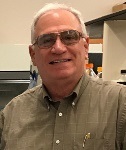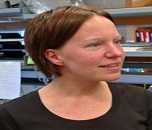Day :
- Mechanisms and Regulation of DNA Repair and Replication Proteins
Location: Canada

Chair
Michael Leffak
Wright State University, USA
Session Introduction
Marc Wold
University of Iowa, USA
Title: DNA repair depends on specialized DNA-binding by replication protein A

Biography:
Marc Wold My laboratory has been study cellular DNA metabolism for more than 20 years. My lab has experience with a wide-range of biochemical, molecular and cellular approaches for analyzing DNA metabolism in vitro and in vivo. We have extensive experience with purification and biochemical analysis of proteins involved in DNA replication and repair. We have either developed or applied many methods for examining DNA binding and functional analysis of RPA in DNA replication and repair. We also carried out structural analysis of RPA and in cell methods for analyzing the function of different forms of RPA or other proteins in human cells. These studies have developed methodology for determining the functions of RPA in cellular DNA replication, DNA repair (including methods for analyzing the efficiency of specific DNA repair pathways) and checkpoint activation. My lab has generated and purified a large number of mutant forms of RPA and analyzed the mechanism of RPA-DNA interactions. We have domain deletion and point mutations at disrupted the function of individual domains of RPA, alter DNA
Abstract:
Replication protein A (RPA), the major single-stranded DNA-binding protein in eukaryotic cells, is required for processing of single-stranded DNA (ssDNA) intermediates found in replication, repair, and recombination. RPA is a highly flexible complex composed of three subunits, RPA1, RPA2 and RPA3 that contain six DNA binding domains (DBDs). One of the recurring mysteries of RPA is that the affinity of RPA for ssDNA does not directly correlate with cellular function. There are RPA mutations that reduce the affinity of the complex by two orders of magnitude are fully active in vitro and in cells, while other mutations that display higher affinity for ssDNA are partially or completely inactive. In particular, we have characterized a set of separation-of-function mutants in RPA1 that have mutations in pairs of aromatic residues in the DNA binding sites of DBD-A or -B. These mutants support DNA replication but are defective in multiple DNA repair pathways including NER and double strand break repair. These results suggest that replication and repair require different RPA-DNA interactions
We utilized single molecule total internal fluorescence microscopy (smTIRF) and ensemble assays to determine the molecular basis of this separation of function phenotype. We analyzed the kinetics of binding to different DNA structures including single-stranded intermediates found at sites of damage and replication. Our studies demonstrated that RPA binds to ssDNA in at least two modes characterized by different dissociation kinetics. We also showed that the aromatic residues contribute to the formation of the longer-lived state, are required for stable binding to short ssDNA regions, and are needed for RPA melting of partially duplex DNA structures. We conclude that stable binding and/or the melting of secondary DNA structures by RPA is required for DNA repair but is dispensable for DNA replication. It is likely that the binding modes are in equilibrium and reflect dynamics in the RPA-DNA complex. This suggests that dynamic binding of RPA to DNA is necessary for different cellular functions.
Michael Trakselis
Baylor University, USA
Title: Excluded strand control of hexameric helicase DNA unwinding

Biography:
Michael Trakselis has expertise in a number of overlapping disciplines of molecular biology, biochemical and biophysical analysis of enzymes, molecular genetics, and cell biology. His laboratory examines the molecular mechanisms and pathways of DNA helicases and polymerases involved in replication and repair. The goals are to uncover novel contacts and interactions that advance our fundamental understanding of these complex processes as well as provide novel targets for inhibition.
Abstract:
Hexameric DNA helicases are a nexus of control for both the initiation and elongation phases of DNA replication. These toroidal enzymes encircle and translocate preferentially on one strand with specific polarities dependent on their families and organismal domains. Over the past few years, there has been an increasing amount of evidence to suggest that the excluded-strand plays a significant role during unwinding by interacting with the helicase’s outer surface in a Steric Exclusion and Wrapping (SEW) mode. This excluded strand interaction appears to be dynamic and can differentially regulate the speed of DNA unwinding in diverse organisms.
We have investigated the interaction of the excluded strand with the outer surface of the bacterial, archaeal, and human hexameric helicases using a variety of biochemical, biophysical, and genetic techniques. We have not only confirmed this external interaction with the exterior surface, we can also show that this interaction regulates the DNA unwinding rate dependent on the unwinding polarity of the organism. Interaction of the lagging strand on the exterior of the archaeal homohexameric SsoMCM helicase is required for efficient and productive unwinding. We have mapped the binding orientation of the homohexameric SsoMCM onto model DNA fork substrates using site specific cleavage agents to show an intermediate in the DNA loading process.
Alternatively, interaction of the leading strand on the exterior of the bacterial DnaB helicase reduces unwinding consistent with the leading strand polymerase being intricately coupled with DnaB during normal replication conditions. In vivo genetically edited exterior mutations of dnaB have growth defects and sensitivities to DNA damage agents. Therefore, interactions with the excluded DNA strand has a previously unknown but influential role in controlling the speed of the replisome, the efficiency of DNA unwinding, and maintaining genomic integrity.
Lata Balakrishnan
Indiana University – Purdue University, USA
Title: Replication protein lysine acetylation regulates the fidelity of the human genome

Biography:
Lata Balakrishnan is an Assistant Professor in the Department of Biology in the School of Science at Indiana University Purdue University Indianapolis. The current research in the Balakrishnan laboratory is focused on understanding the mechanistic reactions of eukaryotic lagging strand DNA synthesis, and the accompanying DNA repair processes. She trained with Dr. Robert Bambara, at the University of Rochester for her post-doctoral fellowship and received her Ph.D. under the mentorship of Dr. Barry Milavetz at University of North Dakota, wherein her dissertation work defined the epigenetic code during viral transcription.
Abstract:
The process of DNA replication needs to occur with extremely high accuracy and efficiency. Mutations incorporated into the genetic code, can cause downstream errors in the creation of proteins, which carry out functional activities within the cell. This in turn directly impacts human health, promoting oncogenesis and faster progression to cancer1. In eukaryotic nuclear DNA replication, the leading strand is synthesized continuously, but the lagging strand must be made as short Okazaki fragments that are later joined. Maturation of the lagging strand is an inherently complex process involving multiple enzymes2. We have found many proteins associated with DNA replication and/or repair to be post-translationally modified by lysine acetylation. Nick translation allows for the displacement of short flaps, followed by cleavage by FEN1 and subsequent ligation. The nuclease activity of FEN1 is diminished on lysine acetylation3. In contrast, acetylation of DNA polymerase delta and Pif1 create longer flaps in the cell, owing to an increase in strand displacement synthesis and helicase function respectively. The acetylated form of RPA binds these displaced flaps with high affinity. Stimulated nuclease function of acetylated Dna2 allows for efficient processing of the flaps for ligation4. Similarly, acetylation of many proteins in the base excision repair pathway promotes the displacement of a longer patch of damaged bases. Additionally, we found that in human cells repair efficiency was diminished in the absence of acetylation5. The displacement of longer flaps would ensure the removal of mismatched bases synthesized by the error-prone DNA polymerase alpha during the maturation phase and damaged nucleotides during the repair process. We propose that lysine acetylation of these proteins acts as a regulatory mechanism that ensures the optimal functioning of the replication/repair associated proteins in a manner that is consistent with promoting genome stability.
- Genetic Diseases
Location: Canada

Chair
Sudha Sharma
Howard University, USA
Session Introduction
Alexandra Sobeck
University of Minnesota, USA
Title: Crosstalk between the Fanconi Anemia and ATRX/DAXX histone chaperone pathways promotes homologous recombination mechanisms in human cells

Biography:
Abstract:
The Fanconi Anemia (FA) pathway functions to repair DNA interstand crosslinks (ICLs). During ICL repair, the central FANCD2 protein promotes the recruitment of downstream factors such as BRCA2[FANCD1] and RAD51[FANCR] that are crucial for homologous recombination (HR) repair of DNA double stranded breaks (reviewed in (1,2)). Previous studies from our laboratory and others showed that FANCD2 also promotes the HR-dependent recovery of hydroxyurea (HU) stalled replication forks (3-6). Intriguingly, we recently identified a new constitutive FANCD2 interactor named ATRX Alpha Thalassemia Retardation Syndrome X-linked). ATRX, in complex with DAXX (Death Domain-Associated Protein 6), acts as a histone H3.3 chaperone that plays key roles at repetitive DNA sequences, including replication fork recovery (7-10). Here, we investigated if FANCD2 and ATRX/DAXX functionally interact to promote the HR-dependent recovery of stalled replication forks, possibly in a histone chaperone-dependent manner.
To dissect cellular roles of FANCD2 and ATRX, we generated isogenic FANCD2-, ATRX- and FANCD2/ATRX-double deficient cell lines using CRISPR/Cas9 gene targeting techniques; moreover, we used siRNA-mediated DAXX knockdown. A dual labeling DNA fiber assay was used to analyze replication fork restart after hydroxyurea (HU)-triggered replication stress. To visualize the recruitment of HR factors to stalled replication forks, we performed immunostaining experiments in the absence/presence of HU.
We found that FANCD2 and ATRX cooperate to promote replication fork restart in concert with DAXX and the MRE11 nuclease. Moreover, we discovered that ATRX supports the FANCD2-dependent recruitment of key HR factors such as CtIP, BRCA2 and RAD51 to stalled replication forks. Importantly, our results also indicate that HR-mediated replication fork restart relies on histone chaperone activities of the FANCD2-ATRX/DAXX complex. Our study suggests that FANCD2 and the ATRX/DAXX complex are involved in chromatin remodeling/histone chaperone processes that take place in the vicinity of stalled replication forks to mediate HR-dependent fork repair.
Oleg Tikhodeyev
Saint Petersburg State University, Russia
Title: The DNA theory of inheritance in the scope of protein inheritance

Biography:
Oleg N Tikhodeyev is the author of the original approach for resolving multiple ambiguities and contradictions in current genetic concepts. He has shown that the key source of such ambiguities and contradictions is the erroneous belief that the same genetic term (for example, mutation) is able to comprise both specific phenomenology and the underlying mechanisms (Tikhodeyev, 2015). This belief became widely accepted after 1952, when the hereditary role of DNA had been demonstrated. In modern genetic concepts, the terms describing molecular mechanisms should be clearly distinguished from those describing phenomenology because there is no strict correlation between phenomenology and molecular mechanisms (Tikhodeyev, 2016).
Abstract:
Statement of the Problem: It has long been accepted that any hereditary factor in any organism is represented by DNA sequences. This idea became fundamental in molecular genetics, and was implicitly transformed into the DNA theory of inheritance. All basic genetic terms (genotype, gene, allele, mutation, recombination, etc.) were considered as specific DNA sequences or their alterations. However, multiple examples of stable epigenetic inheritance lacking any distinctions in DNA sequences were recently discovered, and the most exciting among them is protein inheritance. Amyloid hereditary prions in fungi were considered as “protein-only” hereditary factors, which features were determined entirely by protein conformation. As a result, the principal question arises whether the DNA theory of inheritance is wrong or not.
Methodology & Theoretical Orientation: Considering different variants of the same hereditary prion as prion alleles, we examined the molecular nature of such variety.
Findings: To perpetuate stably in cell generations a certain prion allele requires two entities: specific state of the prion protein, and the corresponding DNA sequence to provide reproduction of the prion particles. We name these entities as the DNA determinant and the epigenetic determinant, respectively. Thus, a certain prion allele is a bimodular hereditary system depending on both the DNA determinant and the epigenetic determinant. Alteration of any of these two determinants may result in establishment of a novel prion allele. Moreover, similar regularities are characteristic to all other cases of epigenetic inheritance, irrespective to the underlying mechanisms.
- CRISPR Biology & Technology
Location: Canada

Chair
Mark Sutton
University at Buffalo, USA
Session Introduction
Rick Russell
University of Texas at Austin, USA
Title: Kinetic basis for DNA target specificity of CRISPR-Cas12a

Biography:
Rick Russell has expertise in quantitative biochemical and biophysical approaches to dissect the activities of enzymes that manipulate RNA and DNA structures. Work from his lab has focused on RNA helicase proteins that function as chaperones in the complex tertiary folding processes of structured RNAs, and additional research has increased our understanding of the folding mechanisms of these RNAs. Recent work from the lab has also included a focus on DHX36, a human helicase protein that efficiently disrupts G-quadruplex structures in DNA and RNA.
Abstract:
Class II CRISPR-Cas nucleases are programmable via a guide RNA, enabling genome editing applications in nearly all organisms. However, DNA cleavage at off-target sites that resemble the target sequence is a pervasive problem that remains poorly understood mechanistically. Here, we use quantitative kinetics to dissect the reaction steps of DNA targeting by Acidaminococcus sp Cas12a (known previously as Cpf1). We show that Cas12a binds DNA tightly in two kinetically-separable steps. Protospacer-adjacent motif (PAM) recognition is followed by rate-limiting R-loop propagation, leading to inevitable DNA cleavage of both strands. Despite the functionally irreversible binding, Cas12a discriminates strongly against mismatches between the DNA target sequence and the crRNA along most of the target, implying substantial reversibility during R-loop formation and a transition state that is much later than for formation of an isolated helix in solution. Dissociation of Cas12a occurs on the time scale of hours, which together with the binding rate constant indicates an overall binding equilibrium constant of 50 fM for a fully matched DNA target. Mismatches throughout the R-loop exert variable effects on the equilibrium, ranging from 10- to 2000-fold weaker binding, with no discernable trend along the target sequence. The ability of Cas12a to discriminate against mismatches throughout the target sequence and the large energetic effects of PAM-distal mismatches defy common descriptions of a ‘seed’ sequence for Cas12a. Further, they raise the possibility of a kinetic origin, rather than a thermodynamic one, for observations of seed sequences in other CRISPR-Cas nucleases including the well-studied Cas9 nuclease. Together, our results provide a quantitative physical underpinning for the DNA cleavage patterns of Cas12a measured in vivo and observations of greater target specificity of Cas12a than Cas9.






